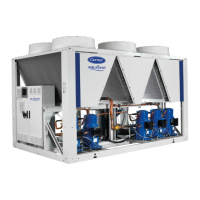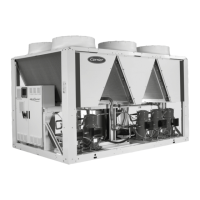24
The minimum heat-transfer uid ow rate is given in the
paragraph "Water exchanger min. water volume and ow
rate".
If the system ow rate is less than the unit's minimum ow
rate, the exchanger ow can be recirculated, as shown in the
diagram.
1 Water heat exchanger
2 Recirculation
If the system ow rate is less than the minimum ow rate, there
may be a high fouling risk.
The minimum heat-transfer fluid flow rate is given in the
paragraph "Water exchanger min. water volume and ow rate".
If the system's ow exceeds the unit's maximum value, it can be
bypassed as shown in the diagram.
1 Water heat exchanger
2 Recirculation
It is limited by the allowable pressure drop for the water
exchanger.
Furthermore, it must ensure a minimum ΔT in the water
exchanger of 2.8 K, which corresponds to a ow rate of 0.09
l/s per kW.
A variable water heat exchanger ow can be used in standard
units. The ow rate must be higher than the minimum ow
given in the table of permissible ow rates and must not vary
by more than 10% per minute.
If the ow rate changes more rapidly, the system should contain
a minimum of 6.5 litres of water per kW instead of 2.5 l/kW.
Whichever the system, the water loop minimum volume is
given by the formula
Volume = Cap (kW) x N litres
Application
Normal air conditioning 2.5
Process type cooling 6.5
CorrectIncorrect
Incorrect Correct
Units with a hydronic module may include an expansion vessel
which limits the volume in the water loop.
The table below gives the maximum loop volume compatible
with the expansion vessel (for pure water or ethylene glycol
depending on the system's various concentrations and static
pressures). If this volume is less than the volume of the installed
loop, then it is necessary to add an extra expansion vessel within
the system.
300-520
1 2 2,5 1 2 2,5
2400 1600 1200 3960 2640 1980
1800 1200 900 2940 1960 1470
1320 880 660 2100 1400 1050
1080 720 540 1740 1160 870
900 600 450 1500 1000 750
Ethylene Glycol

